
Interpreter at Plimoth Plantation, Plymouth, Massachusetts, 2008. (Photo, Gavin Ashworth.) Visible in this interior of a reproduction earthfast dwelling with a tamped earth floor are a shaved chair, a slab bench, baskets, turned bowls, and other wooden artifacts. All these artifacts must continually be repaired and renewed. This provides an opportunity to observe how the objects react to daily use. European paintings and prints help in the reconstruction of such assemblages, which represent interiors dating six years before the earliest extant Plymouth probate inventories.

Right panel from The Annunciation Triptych, attributed to Robert Campin (1375–1444), Brussels, 1425–1430. Oil on panel. 25 3/8" x 10 3/4". (Courtesy, Metropolitan Museum of Art, The Cloisters Collection, 1956 [56.70 a-c], Image © Metropolitan Museum of Art). Joseph’s settle encompasses various woodworking traditions in one object. The back has rectangular members united by draw-bored, rectangular mortise-and-tenon joints. The finials on the rear posts are sawn. The turned front posts, rails, arms, and side stretchers are shown assembled with cylindrical mortises and tenons. The interstices are filled with riven boards. Although it is not visible, the seat is probably constructed of multiple boards running front to rear and captured in grooves plowed in the front and rear seat rails. On Joseph’s workbench is one of the earliest depictions of a brace fitted with a spoon bit, the standard bit used to bore the joints of post-and-rung chairs. The workbench is of post-and-slab construction. The diagonal lattice in the upper panel of the settle’s back admits light to the work surface. It resembles similar lattice used in casement frames, sometimes to form ventilators, sometimes used to back oiled paper or thin cheesecloth.

Board backstool, or Brettstuhl, southeastern Pennsylvania, 1750–1775. Oak and pine. H. 32 1/8", W. 18 1/8", D. 14 5/8". (Courtesy, Winterthur Museum, gift of Henry Francis du Pont; photo, Laszlo Bodo). The Brettstuhl was a Germanic retooling of the Italian board sgabello, a mannerist scrolled and carved seat first used in grottoes and hallways. Eventually the Brettstuhl descended the social scale and became a type of Germanic folk seating, but even those chairs, like this Pennsylvania example, retain the elaborate construction techniques of the carved courtly versions.

Detail of the Brettsthul illustrated in fig. 3. This view shows the two external pins in the through-tenons of the back board and the dovetailed battens of the seat. The octagonal, tapered, shaved legs penetrate through both the dovetailed battens and the seat board and are back-wedged. Something like this construction is seen in prints and paintings of German or Dutch benches with slab or board seats, although their battens tend to be thicker and their stake feet often do not penetrate through the seat.

Slaughterer’s bench, probably New England, 1800–1875. Maple. H. 14 1/2", W. 55", D. 16". (Courtesy, Museum of Fine Arts, Boston, gift of Robert F. Trent in memory of Loren Jesse Pollock (1899-1973), 1983.302, photograph © 2008 Museum of Fine Arts, Boston.) This heavy workhorse is now almost colorless from being scrubbed with lye to neutralize blood. The rough top is made of approximately one-third of a maple trunk. The shaved feet are leveled in chopped and gouged housings and penetrate through the top, where they are back-wedged. Such benches were used principally for butchering swine and had to be heavy and level, for stability. Despite its superficial roughness, the bench is designed and assembled with precision.

Jan van der Straat, Preparing the Eggs of Silkworms, Florence, Italy, 1550–1575. Ink on paper. Dimensions not recorded. (Royal Collection Trust/© Her Majesty Queen Elizabeth II 2013). This drawing shows a set of at least three shaved chairs. They are the most elevated model found in Italian art. The chairs have rounded crests with molded edges and applied roundels, a row of spindles in the back, and conspicuous bridle joints at the tops of the posts. These chairs do not exhibit hewn layback or through-tapering of the sides of the posts. Despite the hobby with which the aristocratic women are occupied, the chairs are not low-seated and do not appear to be utilitarian in intent.
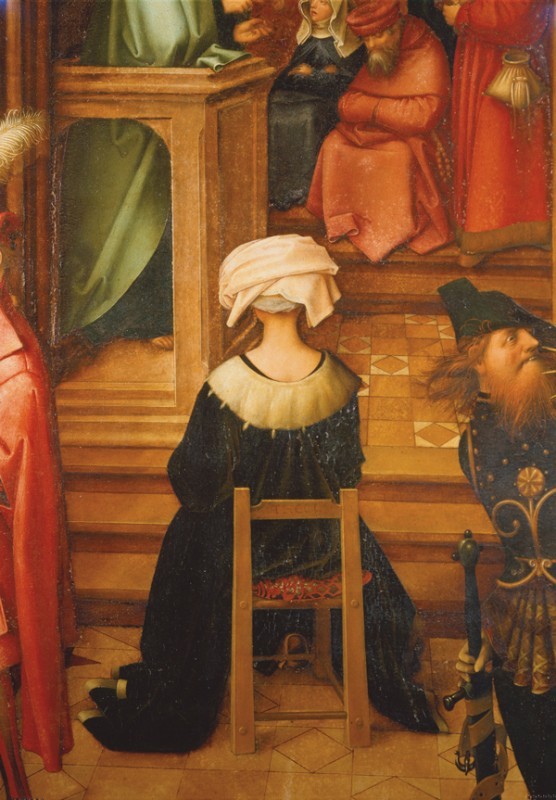
Hans Holbein the Elder (ca. 1465–1524), detail from The Martyrdom of Saint Paul, Augsburg, Bavaria, ca. 1504. Oil on panel. Dimensions not recorded. (Courtesy, Bayerischen Stadtsgemaldsammlungen, Munich.) This view shows a woman seated in a one-slat shaved chair with through-tenons and through-tapered posts. This painting was illustrated in Irving P. Lyon, “Square-Post Slat-Back Chairs,” Antiques 20, no. 4 (October 1931): 210–16, at p. 211, and was used in the formulation of the chairs shown in figs. 16–18.

Paul Velner, The Cobbler, in Das Hausbuch der Mendelschen Zwölfbrüderstiftung zu Nürnberg, fol. 93 verso, Nuremberg, Bavaria, 1474. Watercolor on paper. Dimensions not recorded. (Courtesy, Stadtbibliothek Nuernberg.) This cobbler is seated in a shaved armchair with stick arms and one slat. The posture of the cobbler suggests that the seat of this chair is normal in height. The posts appear to be slightly through-tapered on the sides. The artist incorrectly included a through-tenon on the side elevation of the top of the front post.
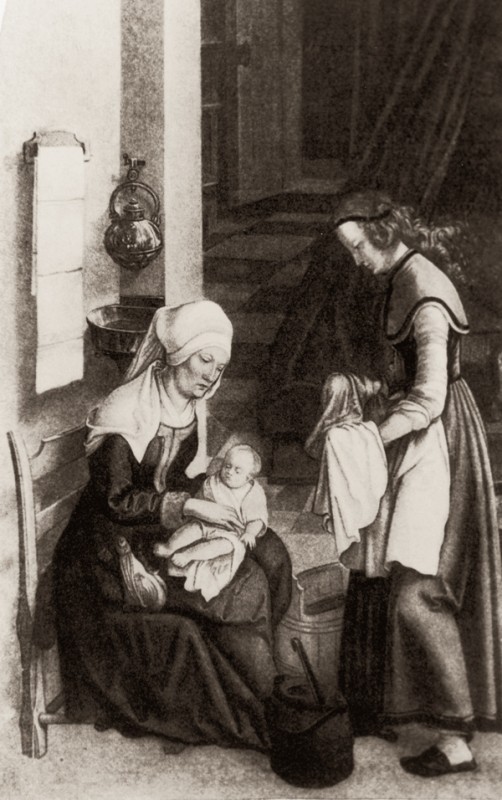
Hans von Kulmbach (ca. 1485–1522), detail from Birth of the Virgin Mary, Nuremberg, 1510–1520. Oil on panel. Dimensions and present location unknown. (Otto von Falke, Deutsche Möbel des Mittelalters und Renaissance [Stuttgart: Juluis Hoffman, 1924], p. 51.) The low-seated shaved chair in which the nurse swaddling the Virgin Mary is seated has one tier of rungs and two slats. The posts have long chamfers between the joints and what appear to be bent tops. Elsewhere in the room are a cradle with board sides tenoned into posts, a trestle table, a board bench with hinged back, and a stand with a spindle gallery to hold a bowl under a wall font.

Michael Sweerts, The Academy, Brussels, 1656–1658. Oil on canvas. Dimensions not recorded. (Courtesy, Frans Halsmuseum, Haarlem, the Netherlands.) This depiction of art students shows them seated on three-slat shaved chairs. The slats are roughly riven and have arc-shaped cuts on the ends on both top and bottom edges, save for the top slats, which have a straight bottom edge. The chairs are through-tenoned fore and aft but have blind tenons side to side. They appear to have seats about 14–15" high. Another important aspect of this view is that the chairs are part of a set of at least twelve chairs.

Armchair, Ipswich, Massachusetts, 1650–1700. Maple and ash. H. 37 1/2", W. 25", D. 18". (Courtesy, Historic New England, gift of Constance McCann Betts, Helena Woolworth Guest, and Frasier W. McCann, 1942.3110.) Irving P. Lyon stated that this armchair was acquired by interior designer Henry Davis Sleeper (1878–1934) from the Choate House on Hog Island in Ipswich Harbor in 1919 (Irving P. Lyon, “Square-Post Slat-Back Chairs,” Antiques 20, no. 4 [October 1931]: 211–12.)

Armchair, Plymouth County, Massachusetts, 1650–1720. Maple, oak, and ash. H. 36 3/4", W. 20 3/4", D. 18". (Courtesy, Museum of Fine Arts, Boston, H. E. Bolles Fund, 1971.190, photograph © 2008 Museum of Fine Arts, Boston.) This chair displays the roughest workmanship of the surviving early New England shaved armchairs. Both arms and one side stretcher are either altered or replaced. Traces of red paint remain on the frame.

John D. Alexander Jr. and Robert F. Trent, armchair, Baltimore, Maryland, 1998. Oak. H. 38 1/8", W. 22", D. 17". (Private collection; photo, Gavin Ashworth.)
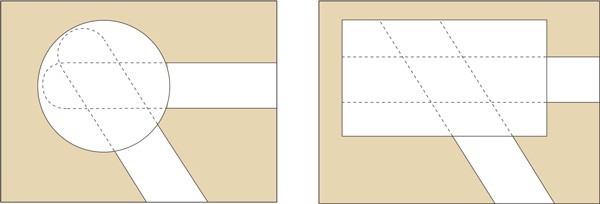
Layout diagrams of side stretchers entering posts. The left diagram shows stretcher tenons entering a turned post, where aiming the mortises for the center of mass is obligatory. The right diagram shows a similar approach in a chair with rectangular shaved posts, wherein the side joints are located at the center of mass, rather than the mathematical center of the rear face of the post. This practice ensures that the through-tenons on the front faces of the posts do not exit too near the front corners.

John D. Alexander Jr., armchair, Baltimore, Maryland, 1998. Oak. H. 38", W. 24 3/4", D. 18 1/2". (Private collection; photo, Gavin Ashworth.) Many early European prints and paintings depict shaved slat-back chairs as slender as this example. Second or upper rear stretchers are rare in Anglo-American chairs but common in Continental examples.

John D. Alexander Jr., side chair, Baltimore, Maryland, 2000. Red oak and white oak. H. 27 7/8", W. 18 1/2", D. 14 7/8". (Private collection; photo, Gavin Ashworth.) Aspects of this chair’s design were derived from the Holbein painting illustrated in fig. 7.

John D. Alexander Jr., side chair, Baltimore, Maryland, 2000. Red oak and white oak. H. 27 5/8", W. 18 3/8", D. 14!÷@". (Private collection; photo, Gavin Ashworth.) All of the study side chairs made by Alexander have through-tapered rear posts. The slats and tenons do not protrude as much as those on the chair illustrated in fig. 16, and the slats are parallel to the front faces of the rear posts. On many period chairs, the slats are centered on the inner faces of the rear posts.

John D. Alexander Jr., side chair, Baltimore, Maryland, 2000. Red oak and white oak. H. 27", W. 19 1/4", D. 15". (Private collection; photo, Gavin Ashworth.) The design of this example was influenced by chairs with shaved rear posts and turned front posts in Lyon’s article (Irving P. Lyon, “Square-Post Slat-Back Chairs,” Antiques 20, no. 4 [October 1931]: 213, fig. 8; 216, fig. 20).
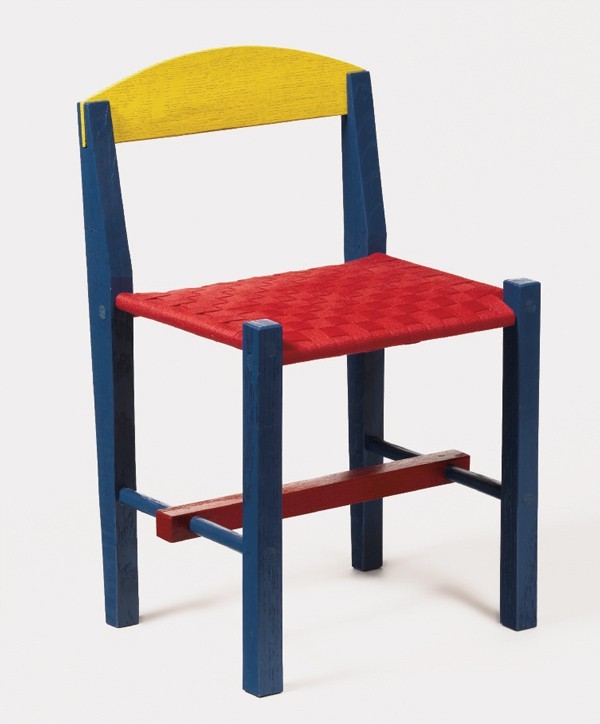
John D. Alexander Jr. and Nathaniel Krause, side chair, Baltimore, Maryland, 1998. Red oak; cotton canvas tape, and paint. H. 25 3/4", W. 15 1/2", D. 13". (Private collection; photo, Gavin Ashworth.)
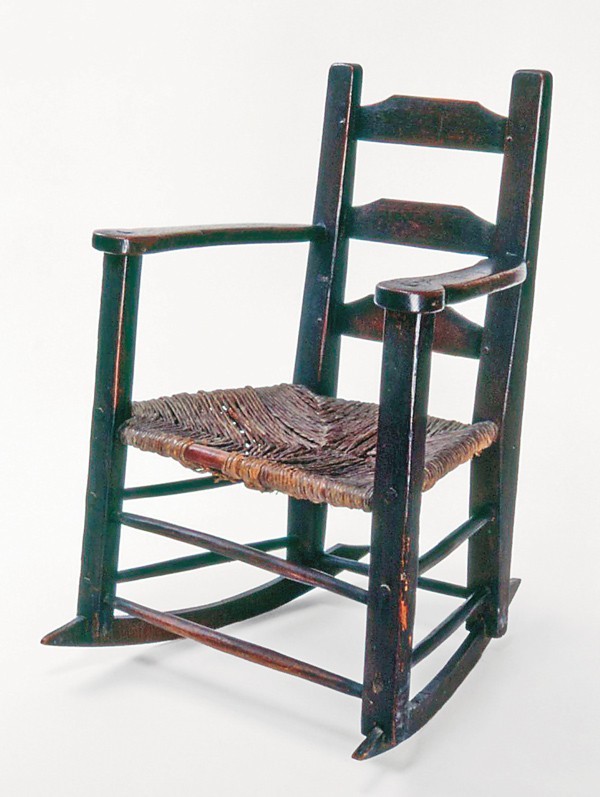
Armchair, probably Braintree, Massachusetts, 1650–1700. Oak and ash. H. 34 3/8" (without rockers), W. 23 5/8", D. 18". (Courtesy, Concord Museum, Concord, Mass.) This chair displays severe tapering of the front and back faces of the rear posts above and below the seat but no taper on the sides. The slats are remarkably shallow in height and have discrete, arc-shaped cuts at the ends.

Armchair, eastern Massachusetts, 1675–1725, illustrated in Irving P. Lyon, “Square-Post Slat-Back Chairs,” Antiques 20, no. 4 (October 1931): 211, fig. 3. This chair has no provenance, but it seems early in date and is in the English tradition. Its posts are tapered in a manner similar to those of the Thompson chair (fig. 20). The three back rails are parallel to the front faces of the rear posts and are pinned, but they are not flush with the front faces of the posts. A central lobe may have broken off the center of the upper back rail.

Armchair, probably Kingston, New York, 1650–1725. Oak. H. 37 3/8", W. 26", D. 18". (Courtesy, Senate House State Historic Site, Kingston, New York, New York State Department of Parks, Recreation and Historic Preservation; photo, Gavin Ashworth.) Although this chair has no history, it may have been collected in the Kingston area early in the twentieth century, when the Senate House functioned as a local historical society. The protruding tenons are the most pronounced seen in any early American shaved chair.
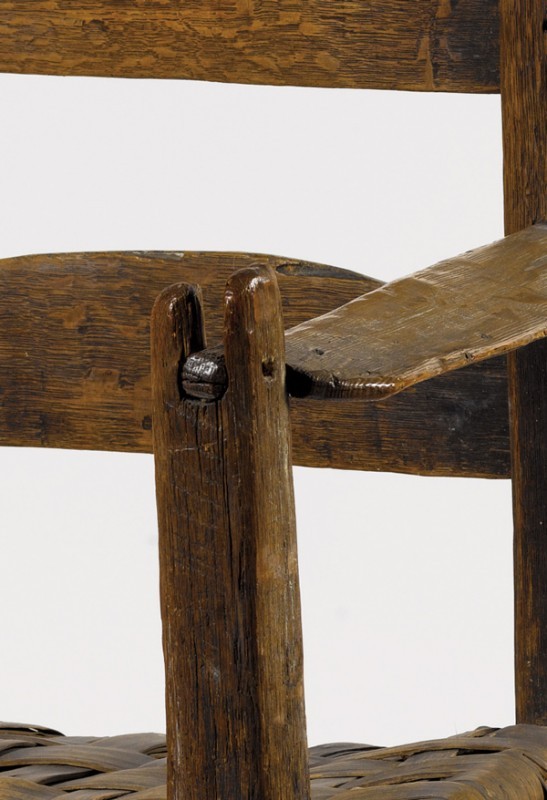
Detail of the right arm on the armchair illustrated in fig. 22. (Photo, Gavin Ashworth.) The maker used a drawshave to shape the rounded ends. The arms are pinned to prevent the arms from rotating in their mortises.
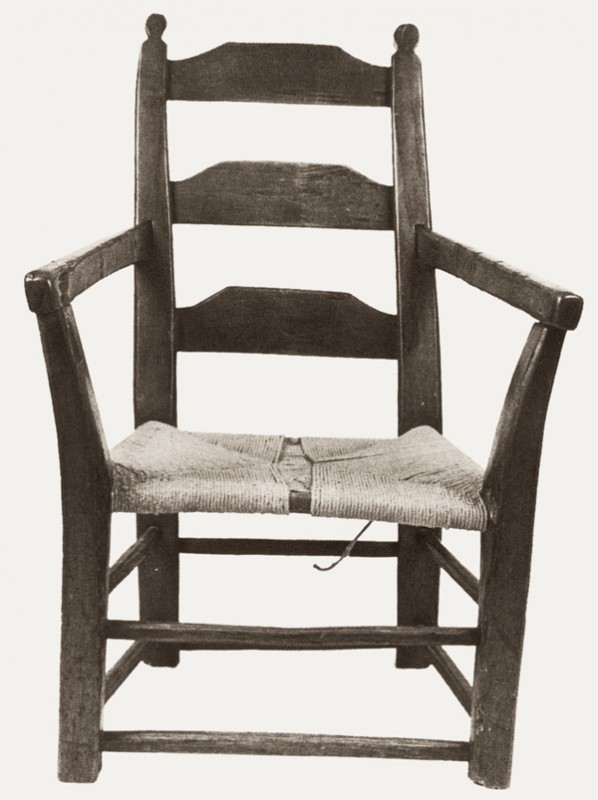
Armchair, Sandwich, Massachusetts, 1719. Maple and ash. H. 36 3/4". (Brian Cullity, “A cubberd, four joyne stools & other smalle things”: The Material Culture of Plymouth Colony and Silversmiths of Plymouth, Cape Cod and Nantucket [Sandwich, Mass.: Heritage Plantation of Sandwich, 1994], p. 121.)
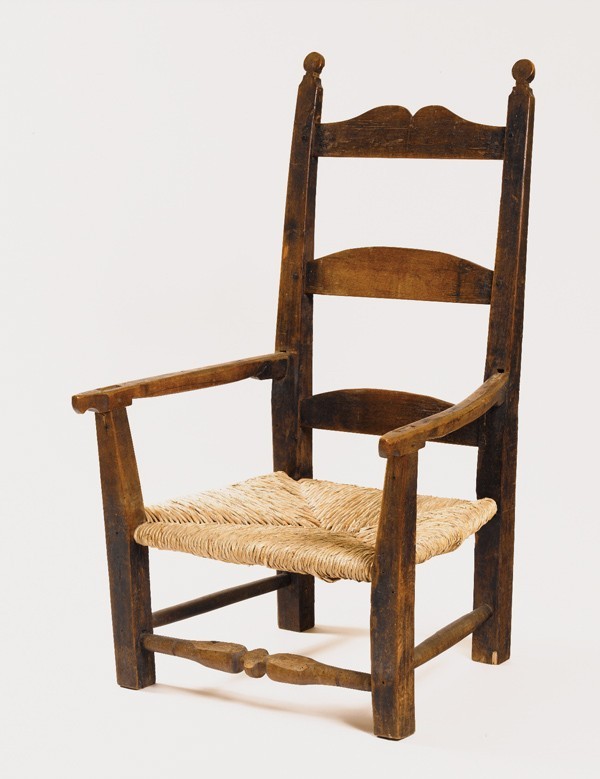
Armchair, Sandwich, Massachusetts, 1775–1800. Maple and oak. H. 39 7/8", W. 23", D. 23". (Benjamin Nye Homestead and Museum, Nye Family of America Association, East Sandwich, Massachusetts; photo, Gavin Ashworth.) The Nye armchair has lost about 6 inches at the bottom and probably has lost a tier of side stretchers and a rear stretcher. The arms are of a form associated with the third quarter of the eighteenth century, making this an extremely late shaved chair.

Armchair, Montague, New Jersey, 1740–1780. Maple and ash. H. 51 1/4", W. 23 1/2", D. 21 1/2". (Chipstone Foundation; photo, Gavin Ashworth.) High-backed chairs of this size almost certainly date after 1725. The frame appears never to have had paint or a resin coating, and the inner bark seat may be the original one.
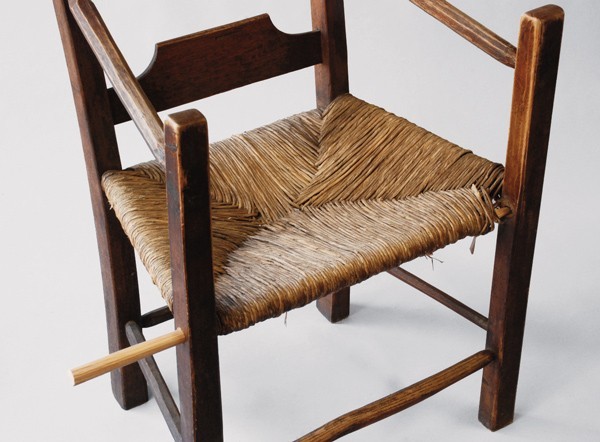
Photo showing the replacement of the broken front rung of a reproduction chair made by Robert Tarule for Plimoth Plantation. (Courtesy, Plimoth Plantation; photo, Peter Follansbee.) The broken front rung was removed by boring the tenons. The new rung is being driven through the front post toward the opposite mortise. The replacement rung must be pinned or back-wedged to remain in position.

Peter Follansbee, side chair, Plymouth, Massachusetts, 1998. Maple and oak. H. 32 1/4", W. 19", D. 15 1/2". (Courtesy, Plimoth Plantation; photo, Gavin Ashworth.) This chair was charred while in use near a hearth. It has been cleaned but has not required any replacements. Undoubtedly many period chairs continued to be used after experiencing far more extensive damage than this.
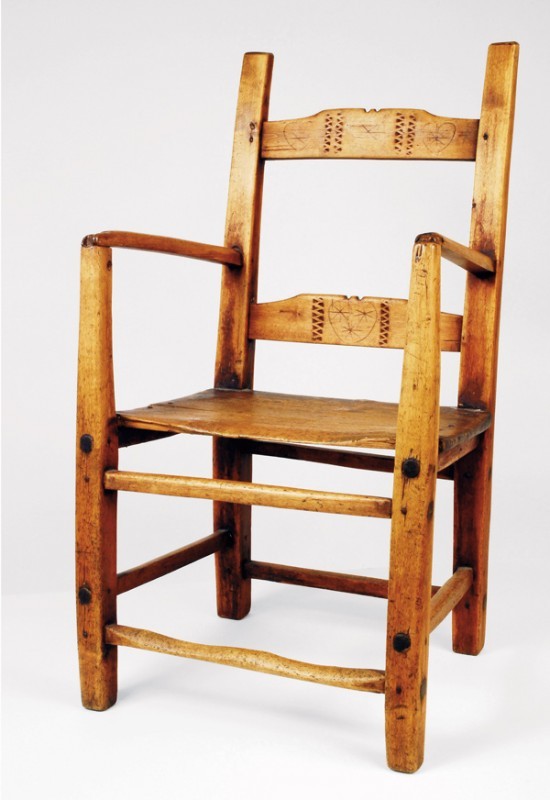
Armchair, Keels, Newfoundland, 1800–1825. Birch and pine. H. 34", W. 26 1/2", D. 14 1/2". (Courtesy, The Rooms—Provincial Museum, St. John’s, Newfoundland, Canada, Walter and Sally Peddle Outport Furniture Collection.) The joints are secured with small wooden pins, supplemented with nails in the seat rails. The rear posts taper above and below the seat in imitation of neoclassical joined seating. Chairs with board seats nailed or pegged to the seat rails commonly appear in vernacular seating from the British Isles, Ireland, and Canada.
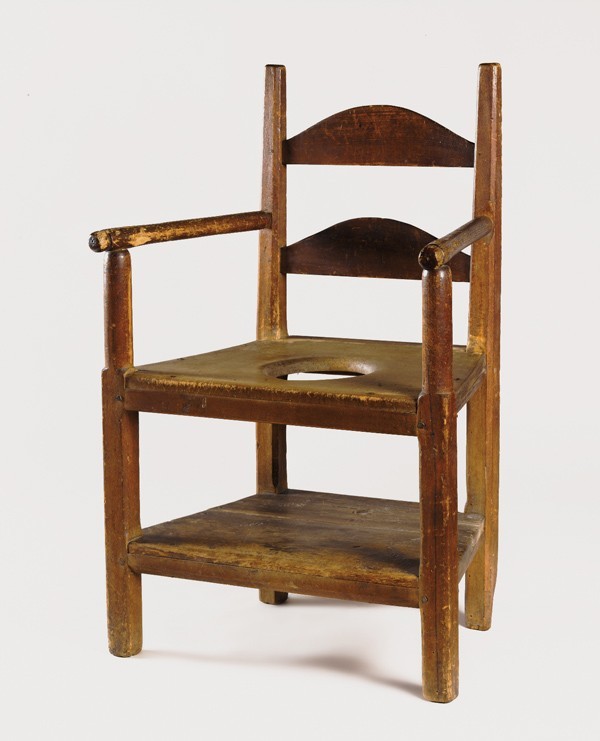
Armchair, Topsfield, Massachusetts, 1725–1800. Maple and pine. H. 40", W. 26 1/4", D. 18 3/4". (Courtesy, Parson Capen House, Topsfield Historical Society, Topsfield, Massachusetts; photo, Gavin Ashworth.) The chair is stamped “D. LAKE.” Its frame combines joined, turned, and shaved work. The seat rails run side to side and the stretchers have rectangular mortise-and-tenon joints. All other joints have round mortises and tenons.
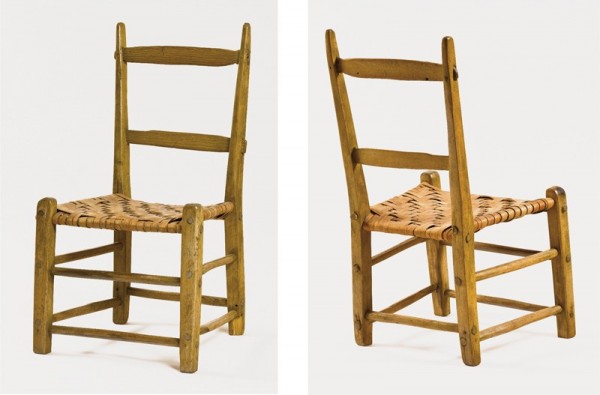
Side chair, probably Nova Scotia, Canada, 1820–1870. Birch and ash. H. 29 7/8", W. 14 3/4", D. 17 3/4". (Courtesy, Plimoth Plantation; photo, Gavin Ashworth.) The maker used billets, or blanks, approximately 3 1/2 inch square for the posts. He probably began by striking lines first to establish the bottom part of the posts, then to establish the skews above the seat. The diameters of the stretchers are much greater than those of the tenons worked on their ends. The maker used a drawknife to shave the ends of the stretchers to conform to the diameter of the mortises. Because the posts were relatively wet at the time of assembly, they shrank around the irregular tenons, binding them securely.

Side chair, probably Wilmington, Delaware, 1730–1760. Sassafras. H. 40 1/4", W. 18 1/4", D. 17". (Courtesy, Winterthur Museum; photo, Laszlo Bodo.) The posts have subtle tapers and scratch-stock moldings. Most of the joints have rectangular through-tenons, and all are back-wedged including the round seat rail tenons. Remarkably, many of the back-wedged joints are further secured by redundant pinning. The chair may have come from the Robinson House on Naaman’s Creek near the Delaware River in Wilmington. The core of the house probably dates ca. 1723, but the structure may incorporate portions of a seventeenth-century Swedish fort that stood on the site.
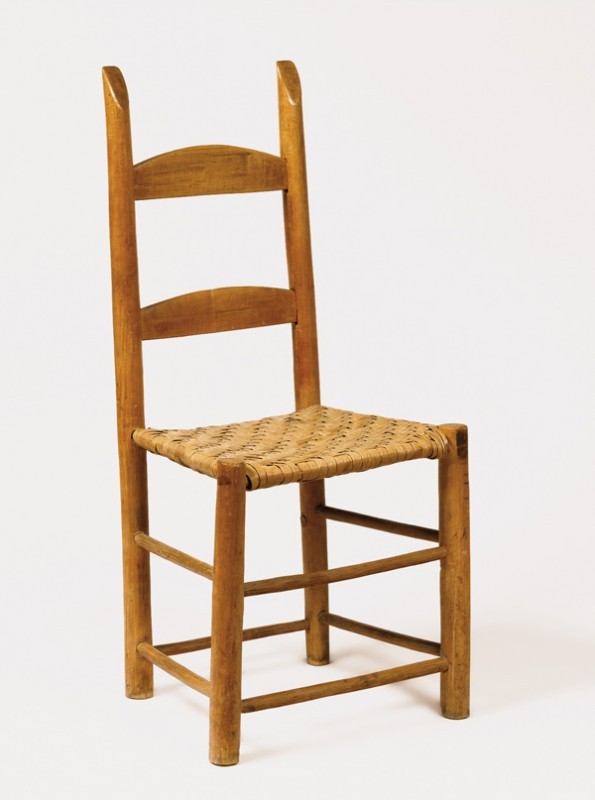
Side chair, Virgilina, Virginia, ca. 1903. Maple. H. 37", W. 17", D. 17 1/4". (Courtesy, Winterthur Museum, gift of Robert F. Trent.) The Moses Hall chairs were discovered by Halifax, Virginia, dealer Robert Pottage, who began acquiring them from local families in the 1960s. The chairs have flat riven slats and were never painted.

Settin’ chair illustrated in Henry Glassie, Pattern in the Material Folk Culture of the Eastern United States (Philadelphia: University of Pennsylvania Press, 1968), p. 230, fig. 66c. (Reprinted with permission of the University of Pennsylvania Press.) Glassie photographed this shaved chair while conducting field research in Gum Spring, Louisa County, Virginia, in 1966. Although he recalls seeing similar examples at that time, shaved settin’ chairs are rare.

Side chair, probably western North Carolina, 1860–1920. Oak and ash. H. 30 1/2", W. 18 3/4", D. 16 3/4". (Private collection; photo, Gavin Ashworth.) This chair was found in an abandoned cabin in Burnsville, Yancey County, in western North Carolina.

John D. Alexander Jr., side chair, Baltimore, Maryland, 2005. White oak and red oak. H. 33 1/4", W. 17 1/2", D. 16 3/4". (Private collection; photo, Gavin Ashworth.)
